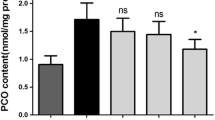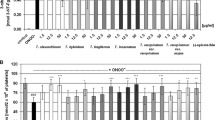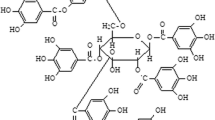Abstract
Thein vitro oxidative hemolysis of human red blood cells (RBC) was used as a model to study the free radical induced damage of biological membranes and the inhibitory effect of natural antioxidants. The hemolysis was induced by a water-soluble free radical initiator 2,2′-azo(2-asmidinopropane) dihydrochloride (AAPH) and inhibited by the principal polyphenolic components extracted from green tea leaves, i.e. (-)-epicatechin (EC), (-)-epigallocatechin (EGC), (-)-epicatechin gallate (ECG), (-)-epigallocatechin gallate (EGCG) and gallic acid (GA). Addition of AAPH at 37°C caused fast hemolysis after a short period of inhibition period, while addition of the green tea polyphenols efficiently suppressed the hemolysis in the activity sequence of EGCG > EGC> ECG ≈EC>GA, demonstrating that these green tea polyphenols are effective antioxidants which could protect biological membranes from free radical induced oxidative damage.
Similar content being viewed by others
References
Mark, A., Trying to unlock the mysteries of free radicals and antioxidants, The Scientist, 1996(Sept. 30): 13.
Bland, J. S., Oxidants and antioxidants in clinical medicine: past, present and future potential, J. Nutr. Envir. Med., 1995, 5(3): 255; and references cited therein.
Rice-Evans, C. A., Diplock, A. T., Current status of antioxidant therapy. Free Radical BioJ. Med., 1993, 15(1): 77.
Salah, N., Miller, N. J., Paganga, G. et al., Polyphenolic flavanols as scavengers of aqueous phase radicals and as chain-breaking antioxidants, Arch. Biochem. Biophys., 1995, 322(2): 339.
Guo, Q., Zhao, B., Li, M. et al., Studies on protective mechanisms of four components of green tea polyphenols against lipid peroxidation in synaptosomes, Biochim. Biophys. Acta, 1996, 1304(2): 210.
Jankun, J., Selman, S. H., Swiercz, R. et al., Why drinking green tea could prevent cancer, Nature, 1997, 387(6): 561.
Jia, Z. -S., Zhou, B., Yang, L. et al., Antioxidant synergism of tea polyphenols and α-tocopherol against free radical induced peroxidation of linoleic acid in solution, J. Chem. Soc. Perkin Trans. 2, 1998(4): 911.
Zhou, B., Jia, Z. -S., Chen, Z. -H. et al., Synergistic antioxidant effect of green tea polyphenols with α-tocopherol on free radical initiated peroxidation of linoleic acid in micelles, J. Chem. Soc. Perkin Trans. 2, 2000(4): 785.
May, J. M., Qu, Z. -C, Mendiratta, S., Protection and recycling of α-tocopherol in human erythrocytes by intracellular ascorbic acid. Arch. Biochem. Biophys., 1998, 349(2): 281.
Niki, E., Komuro, E., Takahashi, M. et al., Oxidative hemolysis of erythrocytes and its inhibition by free radical scavengers, J. Biol. Chem., 1988, 263(36): 19809.
Kuang, Z. -H., Wang, P. -E., Zheng, R. -L. et al., Making vitamin C lipo-soluble enhances its protective effect against radical induced hemolysis of erythrocytes, Chem. Phys. Lipids, 1994, 71(1): 95.
Coxon, D. T., Holmes, A., Ollis, W. D. et al., Flavanol digallates in green tea leaf, Tetrahedron, 1972, 28(10): 2819.
Jia, Z. -S., Zhou, B., Yang, L. et al., 2D NMR study on tea polyphenols, Chinese J. Magn. Reson., 1998, 15(1): 23.
Liu, Z. -Q., Yu, W., Liu, Z. -L., Antioxidative and prooxidative effects of coumarin derivatives on free radical initiated and photosensitized peroxidation of human low-density lipoprotein, Chem. Phys. Lipids, 1999, 103(1): 125.
Liu, Z. -L., Wang, P. -F., Liu, Y. -C., Studies on bio-antioxidants(V)—inhibition of autoxidation of linoleic acid by vitamin E, vitamin C and lipophilic vitamin C derivatives in micelles, Science in China, Ser. B, 1992, 35(11): 1307.
Esterbauer, H., Ramos, P., Chemistry and pathophysiology of oxidation of LDL, Rev. Physiol. Biochem. Pharmacol., 1995, 127(1): 31.
Yoshino, K., Hara, Y., Snao, M. et al., Antioxidative effects of black tea theaflavins and thearubigin on lipid peroxidation of rat liver homogenates induced by tert-butyl hydroperoxide, Biol. Pharm. Bull., 1994, 17(1): 146.
Author information
Authors and Affiliations
Corresponding author
About this article
Cite this article
Ma, L., Liu, Z., Zhou, B. et al. Inhibition of free radical induced oxidative hemolysis of red blood cells by green tea polyphenols. Chin.Sci.Bull. 45, 2052–2056 (2000). https://doi.org/10.1007/BF03183525
Received:
Issue Date:
DOI: https://doi.org/10.1007/BF03183525




